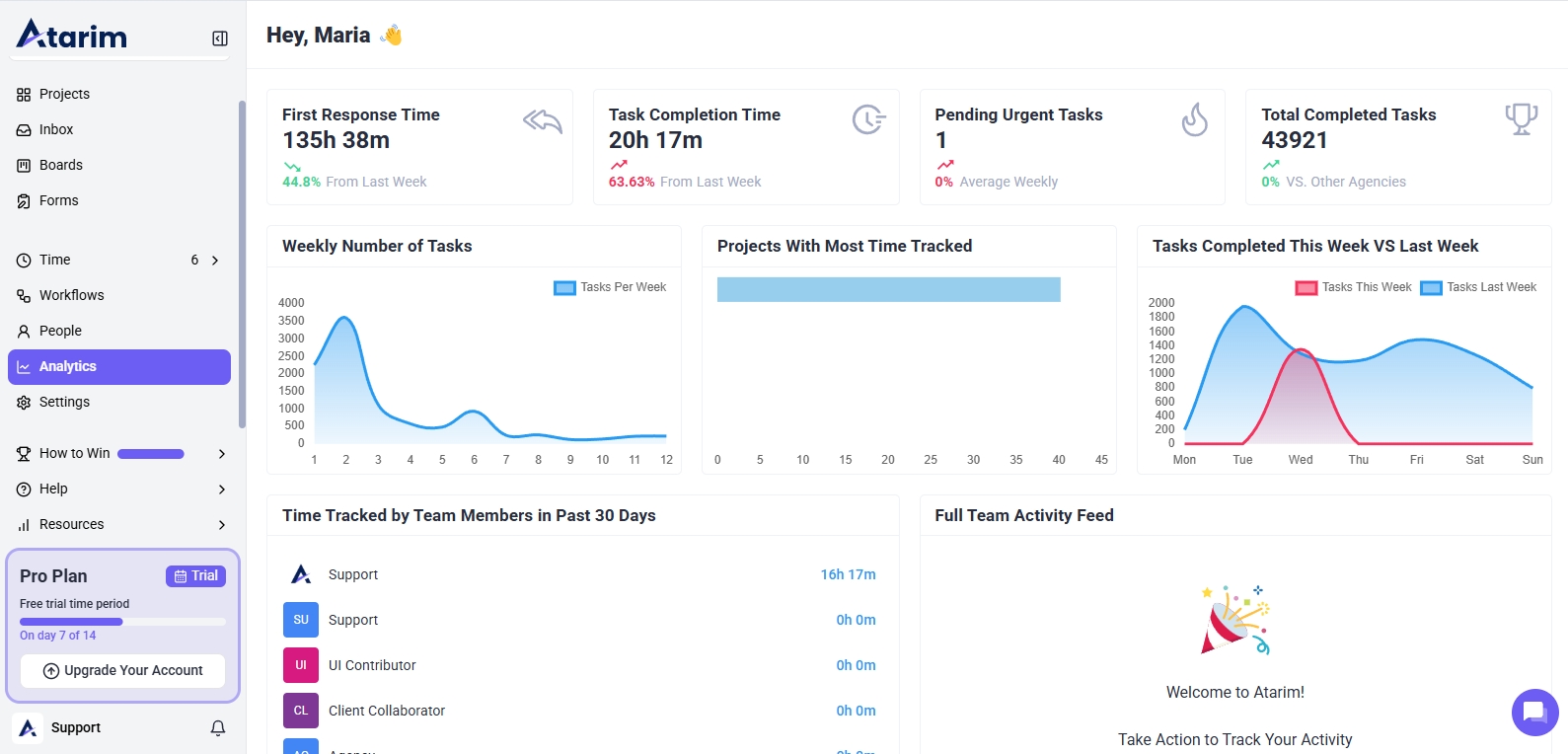Analytics & Metrics
Track, measure, and optimize your team's efficiency with Atarim Analytics.
Atarim’s Analytics Tab provides real-time insights into task management, time tracking, and team activity. By leveraging these metrics, project managers, designers, and stakeholders can optimize workflows, improve response times, and enhance collaboration.
Relevant For
- Team Managers
Prerequisites
- Access to the Atarim Analytics Tab in your workspace.
Step-by-Step Guide
1. Accessing the Analytics Dashboard
Description:
The Analytics Tab gives you an overview of project efficiency, task trends, and response times.
Instructions:
- Log in to Atarim and navigate to your workspace.
- Click on the Analytics tab in the main menu.
- You’ll see various performance metrics categorized for easy access.

Tip: Use filters to focus on specific time periods or projects.
2. Understanding Key Metrics
Response Time Tracking
Measures: The time taken to respond to new tasks.
Why it’s important: Faster response times improve collaboration and project momentum.
Task Completion Insights
Measures: How long it takes to complete tasks over time.
Why it’s important: Helps identify efficiency trends and potential roadblocks.
Pending Tasks & Prioritization
Measures: The number of unfinished tasks, especially urgent ones.
Why it’s important: Enables teams to prioritize high-impact work.
Total Completed Tasks
Measures: The total number of finished tasks per project.
Why it’s important: Allows tracking of team progress and productivity.
Task Trends Over Time
Measures: Task activity in weekly or monthly views.
Why it’s important: Identifies workload patterns and bottlenecks.
Time Tracking by Team Members
Measures: Work hours logged per user.
Why it’s important: Useful for performance evaluations and project budgeting.
Project-Specific Time Tracking
Measures: Which projects have the most tracked time.
Why it’s important: Helps with resource allocation and project planning.
Team Activity Feed
Measures: Recent actions and updates within the workspace.
Why it’s important: Encourages accountability and collaboration.
Note: Use filters to analyze trends over different time periods and compare performance across projects.
3. How Analytics Helps Optimize Workflows
Atarim’s analytics provide actionable insights that help teams:
- Identify Bottlenecks: Spot areas slowing down task completion.
- Improve Time Management: Ensure time is allocated effectively.
- Enhance Team Performance: Adjust workloads based on real-time data.
- Boost Client Engagement: Monitor interactions and ensure timely responses.
- Generate Reports: Export analytics for internal reviews or client updates.
Recommendation: Regularly review analytics to make data-driven decisions for workflow improvements.
FAQs
Workspace admins and team members with the appropriate permissions can access analytics
Yes, you can use date filters to compare productivity trends over weekly, monthly, or custom timeframes.
Tips & Tricks
- Set benchmarks for response times and task completion to measure improvements.
- Regularly review pending tasks to ensure high-priority work is addressed.
- Use time-tracking insights to optimize resource allocation.
Summary
By using Atarim’s Analytics Tab, you can track productivity, optimize workflows, and make data-driven decisions to enhance collaboration.

